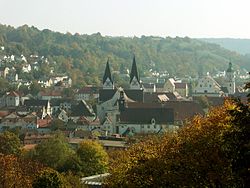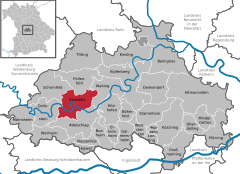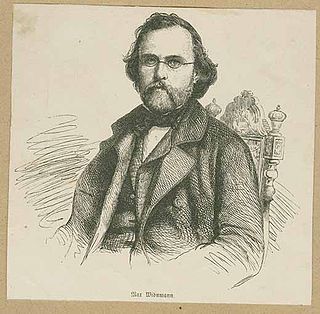Eichstätt
Town in Bavaria, Germany From Wikipedia, the free encyclopedia
Town in Bavaria, Germany From Wikipedia, the free encyclopedia
Eichstätt (German pronunciation: [ˈaɪçʃtɛt]) is a town in the federal state of Bavaria, Germany, and capital of the district of Eichstätt. It is located on the Altmühl river and has a population of around 13,000. Eichstätt is also the seat of the Roman Catholic Diocese of Eichstätt.
This article needs additional citations for verification. (January 2016) |
Eichstätt | |
|---|---|
 Eichstätt | |
Location of Eichstätt within Eichstätt district  | |
| Coordinates: 48°53′31″N 11°11′2″E | |
| Country | Germany |
| State | Bavaria |
| Admin. region | Oberbayern |
| District | Eichstätt |
| Government | |
| • Lord mayor (2020–26) | Josef Grienberger[1] (CSU) |
| Area | |
| • Total | 47.78 km2 (18.45 sq mi) |
| Elevation | 393 m (1,289 ft) |
| Population (2023-12-31)[2] | |
| • Total | 13,867 |
| • Density | 290/km2 (750/sq mi) |
| Time zone | UTC+01:00 (CET) |
| • Summer (DST) | UTC+02:00 (CEST) |
| Postal codes | 85071, 85072, 85067 |
| Dialling codes | 08421 |
| Vehicle registration | EI |
| Website | eichstaett |



Eichstätt lies on both sides of the river Altmühl in the district of Eichstätt of the Oberbayern region of Bavaria, in the heart of Altmühl Valley Nature Park.
Eichstätt is located in a valley of the Franconian Jura and is famous for the quarries of Solnhofen Plattenkalk (Jurassic limestone). On the Blumenberg the Berlin specimen of Archaeopteryx was found by Jakob Niemeyer.
St. Willibald founded the Diocese of Eichstätt on the site of an old Roman station (Aureatum or Rubilocus) in 741.[3] The city was given walls and chartered in 908. It was ruled by a prince-bishop, and in the Holy Roman Empire was the seat of the Bishopric of Eichstätt until secularization in 1802. In 1806, it became a part of the Kingdom of Bavaria. Eichstätt was included as part of the Principality of Eichstätt, which King Maximilian I granted to his son-in-law Eugène de Beauharnais in 1817 and an episcopal see was reestablished in 1821.[citation needed] It reverted to the Bavarian crown in 1855.[3]
In 870, the remains of St. Walpurga were transferred from their original Heidenheim interment to Eichstätt, where in 1035 the newer burial site was enshrined as the Benedictine Abbey of St. Walburga, which continues to this day.[4][5]
In 1943, the painter Karl Friedrich Lippmann moved to Eichstätt and stayed until 1955.
Hortus Eystettensis ("Garden at Eichstätt") is the name of an important botanical book first published in 1613 and written by Basilius Besler.
Allied prisoners of war were held at Oflag VII-B in Eichstätt during World War II. Activities carried on by the prisoners there included attempted escapes and the production of plays and musical works. These included Hamlet and the Comedy of Errors by William Shakespeare, the premiere of Post-Mortem by Noël Coward - featuring Desmond Llewelyn,[6] later best known as Q in the EON Bond movies - and of the Ballad of Little Musgrave and Lady Barnard by Benjamin Britten.[7][8]
The town is dominated by the Willibaldsburg. Besides the cathedral, Eichstätt also has 12 churches and 10 monasteries.
Eichstätt is home to the Katholische Universität Eichstätt-Ingolstadt (KU), the lone Catholic university in Germany. The KU was founded in 1980, and was granted full rights of a university, including Ph.D. and Habilitation degrees by the State of Bavaria.[9]


Seamless Wikipedia browsing. On steroids.
Every time you click a link to Wikipedia, Wiktionary or Wikiquote in your browser's search results, it will show the modern Wikiwand interface.
Wikiwand extension is a five stars, simple, with minimum permission required to keep your browsing private, safe and transparent.